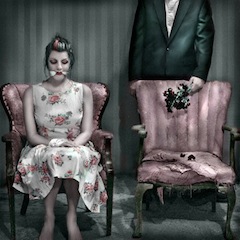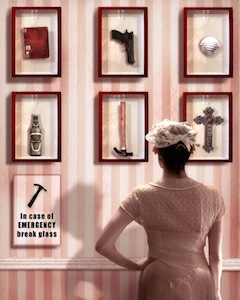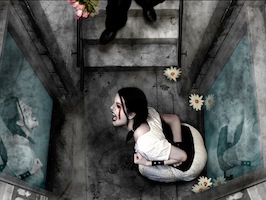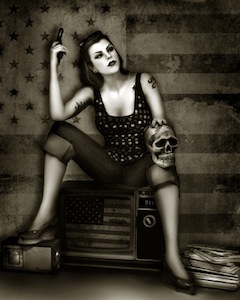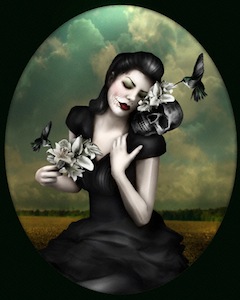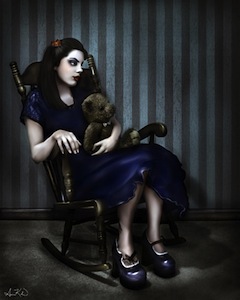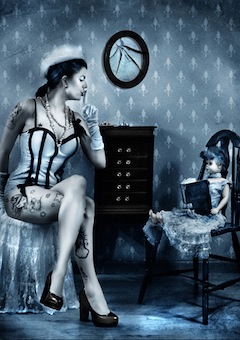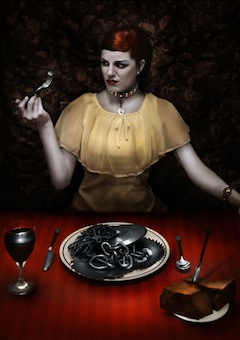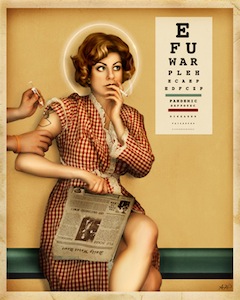I'd say what I'm aiming for is an elegance… a painful elegance.
January 1, 2012
Aunia Kahn creates hybrid visual compositions that involve costumery, photography, painting and digital collage techniques. Much of her work grapples with abuse that she experienced as a child, in a manner that is fanciful and engaging while not shying away from the pain that motivates her creativity. Artocratic Editor Greg Dember interviewed her over the phone from her studio in Illinois. Examples of her work are at right. For more information, visit: www.auniakahn.com
G: Can you start off by giving a history of how you developed your form?
A: In 2001, I moved to another city, 600 miles away from home, and about three weeks later the World Trade Center attack happened, my mom got cancer, and my house was broken into. I'd moved there thinking that I was going to change the pattern of life I grew up with, in which I'd experienced extreme abuse. When all those stresses happened, I started to have panic attacks, and I realized I was still not OK.
This was very disheartening to me because I had felt I had moved on. It was a very bad time in my life that left me almost not-functioning. I had a near-miss car accident, in which I was almost hit by a semi-truck. After that I quit driving. And I became very dependent on staying in my own environment and working on anything – from drawing to painting to making music – anything I could do to wall off the thoughts and the panic. My refuge was art, which is something I'd been passionate about growing up, but not been serious about as an adult. At the same time, I fell in love with the work of a particular artist who I knew. He asked me to work with him and after I posed for a few things, I thought, "Why don't I pose for my own work? I'm an artist – why am I posing for somebody else?"
G: So, claiming yourself, both as artist and as subject.
A: Yes, quite right. At that point I really dove into it and I started producing these crazy pieces of artwork with really intense subject matter. There were women being bound in basements and men holding their hands over women's mouths – a lot of things that obviously were representative of feeling oppressed – trying to express as an adult how I'd felt as a kid, that is, feeling as though I had no voice. So now I was, yes, being my own subject. And in 2005, a friend of mine saw this work and suggested I show it in a gallery.
G: That must have felt gratifying.
A: Actually, what I thought was, "Are you CRAZY?" I seriously thought he was out of his mind. I wasn't going out in public much at that time; why would I take something that is more or less like a private journal and throw it on the wall for people to gawk at? But I do believe that when somebody approaches you with something that you totally oppose, you should totally think about doing it. A couple months later, as it happened, there was a call for a show called "Voices From Within: Surviving Through The Arts." I realized, if I'm going to give this a shot, this is it.
G: It sounds like your work definitely belonged in that show.
A: Yes. I thought, "That's what I'm doing, – Surviving through the arts!" I needed that more than I needed water, more than I needed food. So, I submitted my work, and was accepted, and then I had to go to the show, which was one of the hardest things I've ever done. I watched a woman bawl in front of my art work. I had to go hide in the bathroom. I'm almost in tears right now thinking about it. Seeing her react that way, I felt, "Oh my God... somebody understands... " When I left that night, I understood that not only could this work be healing for me, but it could give me a voice to speak out and stand up for others. To watch people engage with my work, and to know that maybe they are getting something from it too, was a powerful catalyst. It really pushed me to realize that I need to continue with it.
Plus, I've always had the personality of a show person. I've always been interested in being in theater, being in the limelight. But I never was confident enough growing up, because I was one of those kids who was teased so badly that she just retreats into herself. When everybody was standing on stage doing plays or talent contests, or whatever, I would sit there and think, "God, it would be nice to do that, but I can't." So with the artwork, I realized not only that I actually have some talent, but that I can affect other people, and be an entertainer. From there on, I continued being invited to exhibit.
G: The woman who cried at your first show – is she someone you came to know? Do you think she knows what an impact that had on you?
A: No, I was too shy at that point to talk to people, so I never got to experience the kinds of interactions that I do now. I feel like I missed an opportunity to have a kindred conversation, or just a moment of nodding your head in commiseration with one another.
G: What are those interactions like now?
A: When I meet people now who are emotionally touched by my work, I feel way more solid in my ability to interact and connect. Since I've released the intensity of my own emotions and made them available for public consumption, there has been a great amount of healing and letting go. This gives me steadier footing to converse with people who are just starting their journey, who may be coming out of denial or facing their pain for the first time. Often it seems my art gives people a kind of door to a more hopeful place. However I then have to move out of the way and let them walk through it, since I can't hold their hand.
G: It appears that you continue to serve as your own subject in most of your paintings that I've seen. Is this only for convenience and practicality's sake, or is it actually a limitation that you've imposed on yourself for artistic reasons?
A: In the beginning it was a matter of practicality. I didn't have the ability to go out and find models. But even back then, I never wanted to compromise my work based on someone else's needs. I never wanted to have to get permission to do the work that I do. And if I were using another person in my work, it becomes very complicated... Can I do this to you? Do you mind if I do this? I didn't really want to have that conversation. I needed to express what I needed to express. Self-portraiture is a way to directly explore my most complex and difficult emotions.
G: Though you're a visual artist, you're using an approach that's common in songwriting and performing, in that songwriters are usually writing about their own experiences and feelings or at least referencing them and making metaphors of them, and then singing with their own voices and performing on a stage with their own bodies. In other words, with music the expectation is that the expression, the sentiment, and the performance is YOU.
A: I did get into music before I really got going with art. I've been writing songs since I was a kid. So, maybe that has something to do with it.
G: As a musician and songwriter would you say there is a way in which your work in music and your visual artwork are part of a universe together, or are they kind of in separate universes?
A: My first reaction is to say they are a little bit separated. They do crisscross, though. I've named art pieces after songs I've written. Things like that. So I guess they both kind of go in the same universe, along with my poetry and short story writing. It seems that all aspects of my creativity – even my cooking – share that space in my brain. It all comes from the same root.
G: Say more about that.
A: The root – it feels like a seed that was planted in me even before birth. As I move through time and space, I am pulled to create without even thinking about it. That impulse in me must be a part of my genetics and soul. It may be expressed through different modes, but it's all part of the same thing.
G: What about your audience? Do people take in these different sides of you together, or are the art people not necessarily tuning in to the music, or vice versa?
A: I'd say there is often a split. There are some people who follow every piece of what I do in each of those modalities. But then with others, I do find there is a kind of loyalty to one or the other. If they first saw my art, they might say "Oh... well she does music, too.” So, for the most part, if they listen to my music they listen to my music, if they look at my art, they look at my art. But, interestingly, with the writing it seems to go both ways. If they like my art or music, they appreciate my book. Of course, the book has photographs in it and lyrics printed.
G: As you have noted, your work seems to revolve around giving voice to pain that you or other women have experienced due to exploitation or abuse from men. And yet I have to admit, as a man, I find myself drawn in by what feels to me to be a strong erotic dimension to your work. Is that reaction disconcerting to you, and/or is it something you intentionally utilize?
A: It's not disconcerting at all. I have come to understand that my art is going to open people to different reactions that might not be pretty, or might not even be what I intend. I think that my art does have an erotic bent. I hear that from people. Let's face it – it's hard to look at art based on the female form, even if it's a subject matter that's difficult to deal with, and not see it as erotic. [Laughs] But if you wonder if that is what I'm aiming for, I'd say what I'm aiming for is more of an elegance... a painful elegance.
Of course, if you have that juxtaposition it can become erotic and sexy. It makes sense to me that people would look at that and go in that direction and it doesn't bother me, either way. I mean, in the beginning, maybe it would have, when I was way more sensitive. I've grown since that first series, the one that kicked it all off. That first series was really tough. I think I've explored, in my newer work, a lot of things that are more about self-blossoming... a growing out... a coming out.
G: Watching your career build, I've seen you be pretty quick in ramping up your web presence, your online store, and all of that. I really haven't seen any other artists self-manage the business aspect of their career as effectively as you have. Did it require a leap of faith in terms of committing the time and resources necessary to make your artwork widely available?
A: Well, having a background in graphic design and web design, it's been easier to promote myself than for someone who was just good at painting. That's been important, because I've learned that if you're not tooting your horn, no one else is going to. That's just how it is in the entertainment industry, no matter whether it's TV, movies, or any sort art. There are so many people who are artists and everybody is fighting for some piece of the pie to be able to make a living at it. Promotion is a game unto itself, and if you want to win, you have to know that. It's a game. It really is.
G: I think it's interesting that you used the word entertainment, and I think that might be one key to your success. There's kind of a traditional disdain, among a lot of artists, for that category "entertainment," and yet you don't have any shame about it. I mean that in a good way... you don't have that big division.
A: It's true. I view the visual art world as an entertainment industry. It's consumptive, in the same way as in TV or in film. When I put out a new piece of artwork every month, every two weeks, it keeps people interested. People that watch and engage in the art world want to see new work all the time. They want to be your fan. The point is to get it out to the masses, and they can eat it however they want to eat it. Even if feedback isn't good, it doesn't matter, because I really don't care about feedback. I care more about how I'm doing the work. I mean if they don't like it, oh well. So, I definitely don't want to come off like I'm saying that my creations originate in marketing. When the pieces are done, then I apply the marketing.
G: Have you had any interest in, experience in, or call for, teaching?
A: I love to lecture students. I have given talks at colleges and different schools, and I have been offered the opportunity to teach in a more full-time capacity, but I don't have the degree to do so. I didn't go to art school, and I'm not going to go now in order to teach. What I like is inspiring people to take action. Getting them to feel that they can do it. No matter if it's on a really general level, or if it's deeper, say, someone who comes from a really broken place and they come to feel that, yes, I can come out of this through art.
G: Do you ever get called an "outsider artist"?
A: Sometimes. I think what I do is situated between a kind of underground art and fine art. I'm glad I'm not just one or the other. I really love it when people do art that kind of rides that line. And these days, it's becoming more digestible. You're seeing graffiti artists be able to show in museums. I don't have a problem, call it what you want. If you want to call it "cheddar cheese" that's fine.
G: Let's end with a gimmicky interview question: Name a few people, dead or alive, you would you love to have seen your work.
A: OK, I'll start with a dead person, and this will be controversial: Michael Jackson!
G: How come?
A: Because he came from such a horrific environment, and I don't think he was what people think he was. I can just see how I grew up... his interest in childhood things. I mean, I have so many little-kid things that I acquired, trying to get back what I lost. If I was really fucking rich, I'd have Neverland, absolutely.
And I would love for Abraham Lincoln to have seen my work. I'm kind of in love with Lincoln. He reminds me somehow of the way my art is. I love juxtapositions. I love when there is a soft hardness, or there is a confident gentleness, that goes on with people, and I think that is why I have an attachment to him.
G: How about living person?
A: Madonna, the original exhibitionist. She loves to challenge people’s views, and so do I. She is timeless, always changing, growing and experimenting. I like people who experiment, people who I never know what to expect from. Even if they put something out that is not my cup of tea, there's a kind of respect there for their creative drive and vision.



